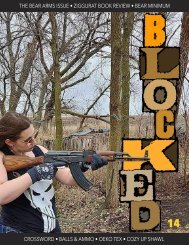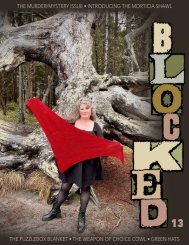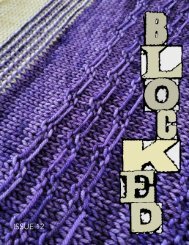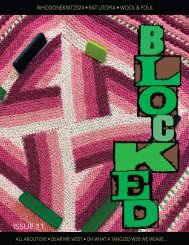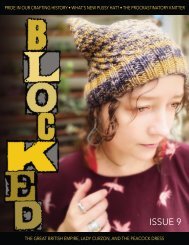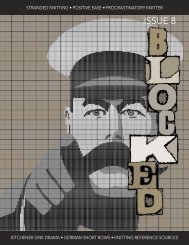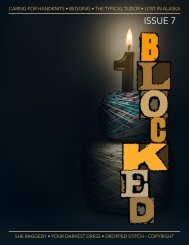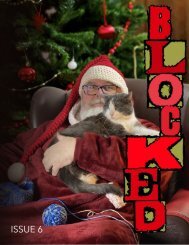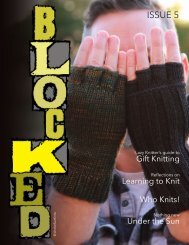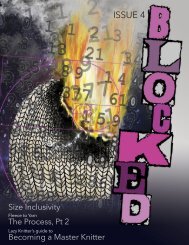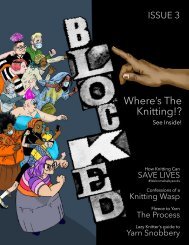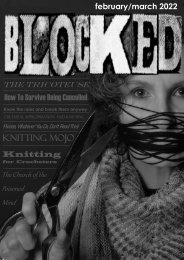blocked_10_final
You also want an ePaper? Increase the reach of your titles
YUMPU automatically turns print PDFs into web optimized ePapers that Google loves.
Number Knitting Continued...<br />
rection for the garment/item, and the stabilising edges<br />
of picked up stitches draws the stitches<br />
back together again.<br />
Another unusual aspect of Virginia’s<br />
method is her use of gauge-shifting.<br />
The gauge recommended can vary incredibly<br />
within a garment or item. For<br />
example, in her Winged Blouse (page<br />
206) the modules are knitted in varying<br />
needle sizes to change the fit of the<br />
item in certain areas. This enables the<br />
patterns to remain simple in presentation<br />
and avoids complicated mathematical<br />
grading.<br />
In general, Virginia’s gauge use is extremely<br />
loose. As a tight knitter, I find<br />
some of her gauges jaw dropping. For<br />
example, the Lanier Circlet: Evening<br />
Hood (page 150) is knitted with a gauge<br />
of 2 stitches to the inch, using a fine<br />
grade yarn!<br />
Virginia’s novel approach doesn’t<br />
end there. Her charts/diagrams are, in my opinion, genius.<br />
Although many of her innovations have been copied<br />
and facsimiled until her virtual watermark/signature<br />
has been eroded, this is one aspect of her work that is<br />
still unique to her.<br />
In the chart/diagram for the ‘Patchwork Blues<br />
Afghan’ Virginia provides all the information needed to<br />
create the blanket. Each square of the graph paper represents<br />
9 stitches x 9 ridges in garter stitch. The gauge is<br />
3 stitches per inch. So, each square (of the paper) equals<br />
3”. The finished piece will measure approximately 60”<br />
long and 27” wide. The box number is a crucial part of<br />
the understanding of Virginia’s patterns. Without this<br />
number the patterns are next to impossible to understand.<br />
The numbers on the colored sections indicate the<br />
order and direction the knitter should work in. This in itself<br />
is impressive. The modules of each pattern in the<br />
book are numbered in an order that eradicates (or significantly<br />
reduces) the need to break the yarn. In this particular<br />
example it probably wasn’t necessary as Virginia<br />
uses four different shades of blue, yet she still maintained<br />
that principle throughout.<br />
Before publishing the book Virginia ran mail-order<br />
classes using the techniques she developed. Kelly has<br />
been trying to track down one of the mail order courses<br />
with no luck (so far). The book is, in and of itself, a full<br />
course in learning to knit, not just Virginia’s methods. I<br />
suspect experienced knitters may miss important information,<br />
or misunderstand parts of the book, by thumbing<br />
ahead to the parts they feel<br />
are aimed at the more experienced.<br />
However, a word of caution,<br />
no matter how experienced<br />
we are as knitters, we are all beginners<br />
when it comes to Virginia’s<br />
unique approach.<br />
As you can probably tell, this<br />
knitting book is amongst my alltime<br />
favourites. If you enjoy the<br />
process of knitting, aren’t looking<br />
for a modern, perfect sweater pattern<br />
in row by row directions, then<br />
it might become one of your favourites<br />
too. If you enjoy modular<br />
knitting and ‘Cosy Memory’ mitresquare<br />
blankets, then I highly recommend<br />
you contact Kelly for<br />
your own pdf copy. It’s telling that<br />
the original modular blanket patterns<br />
herein are still more varied<br />
in placement patterning than any of the modern versions.<br />
(For example, see ‘The Mulbury Bush Afghan’<br />
placement suggestions: page <strong>10</strong>3).<br />
This leads me to what I originally considered to be a<br />
little contentious; the price.<br />
As mentioned, the hard copy books are so rare they<br />
are generally sold well in excess of $500 per copy. There<br />
are library copies around the USA and one copy in the<br />
UK. These are probably going to be difficult to obtain<br />
and, due to rarity, might be available for reference only,<br />
and not to be removed from the library.<br />
There are two electronic versions available to buy.<br />
The first version is a pdf at $74.99 from Kelly’s own<br />
Knitswag site: Number Knitting: The New All-Way<br />
Stretch Method, Digital Scan of The O – KnitSwag<br />
The other is a Kindle ebook at $39.99 From Amazon:<br />
Amazon.com: Number Knitting: The New All Ways<br />
Stretch Method eBook : Bellamy, Virginia Woods: Kindle<br />
Store<br />
At almost half the price you would think the<br />
Kindle/Amazon copy the obvious choice. However, the<br />
Amazon version has some quite strange formatting, you<br />
can’t print from it, and many of the photographs are<br />
blurred. Whereas the Knitswag version is printable, has<br />
colorised charts, clickable annotations, and is generally<br />
of far superior quality.<br />
Initially I struggled with Kelly’s justification for charging<br />
$74.99 until I learned just how much work she clearly<br />
put into creating the pdf. It isn’t as simple as just scan-<br />
Continued on next page...<br />
24





